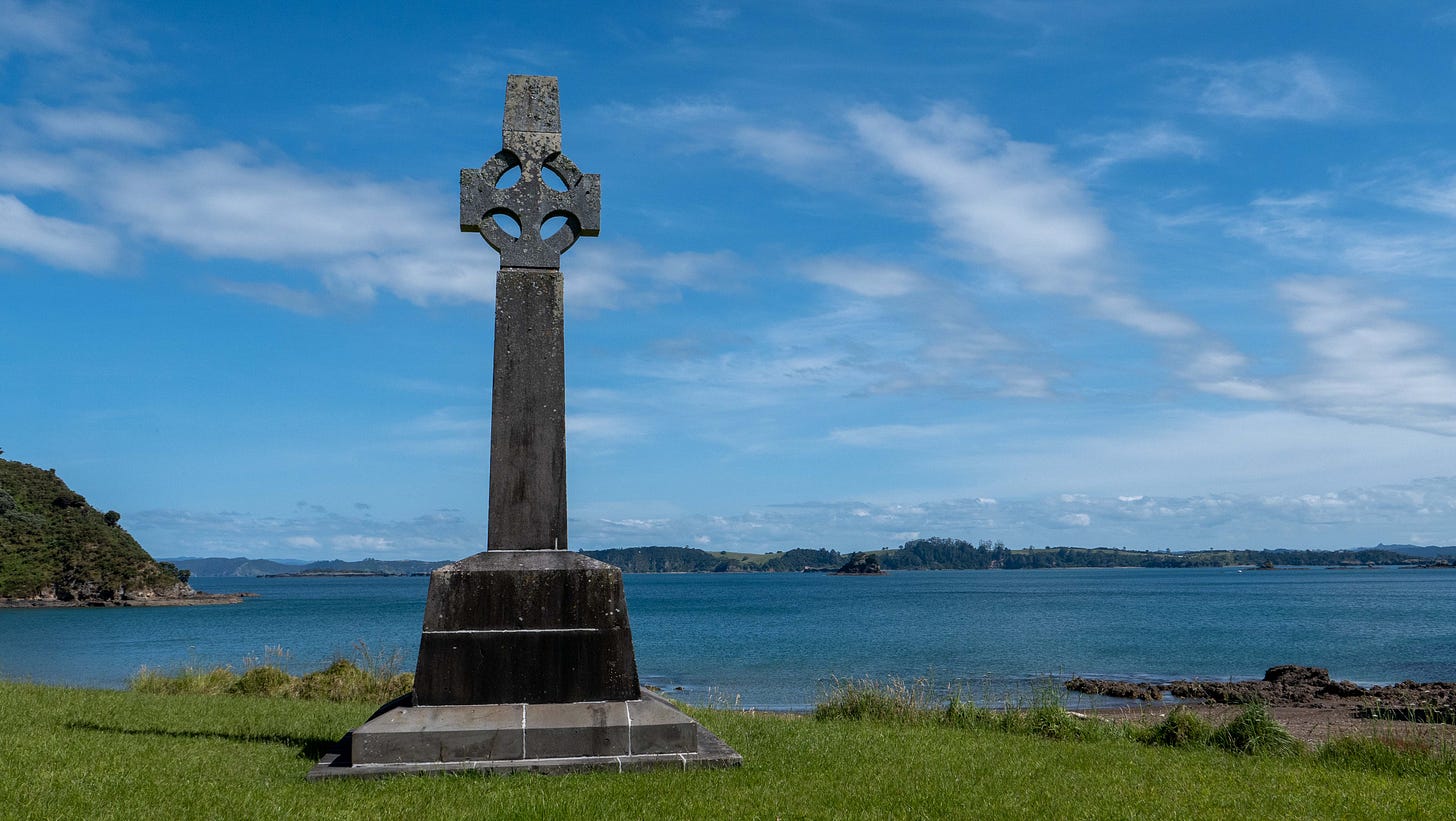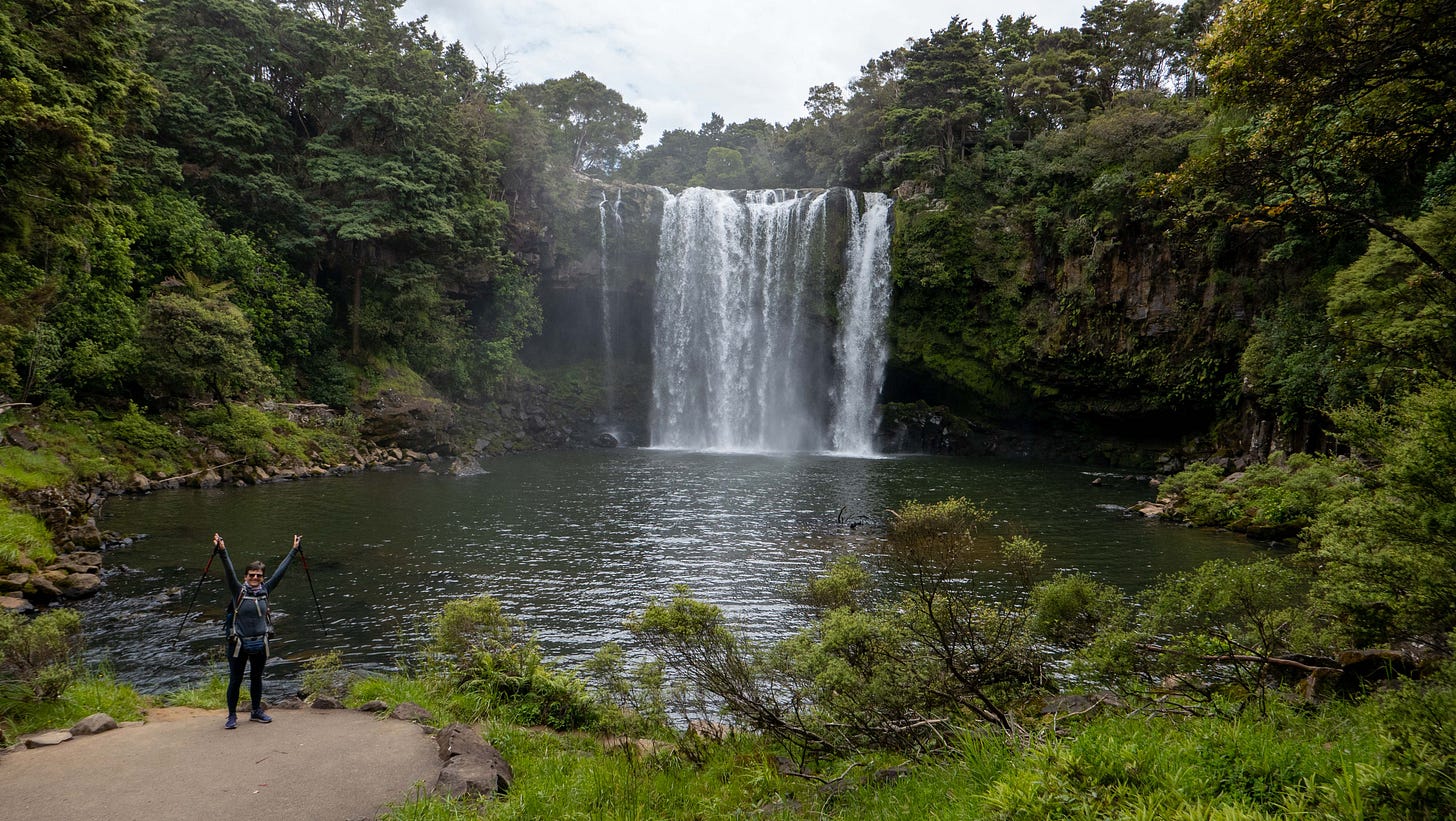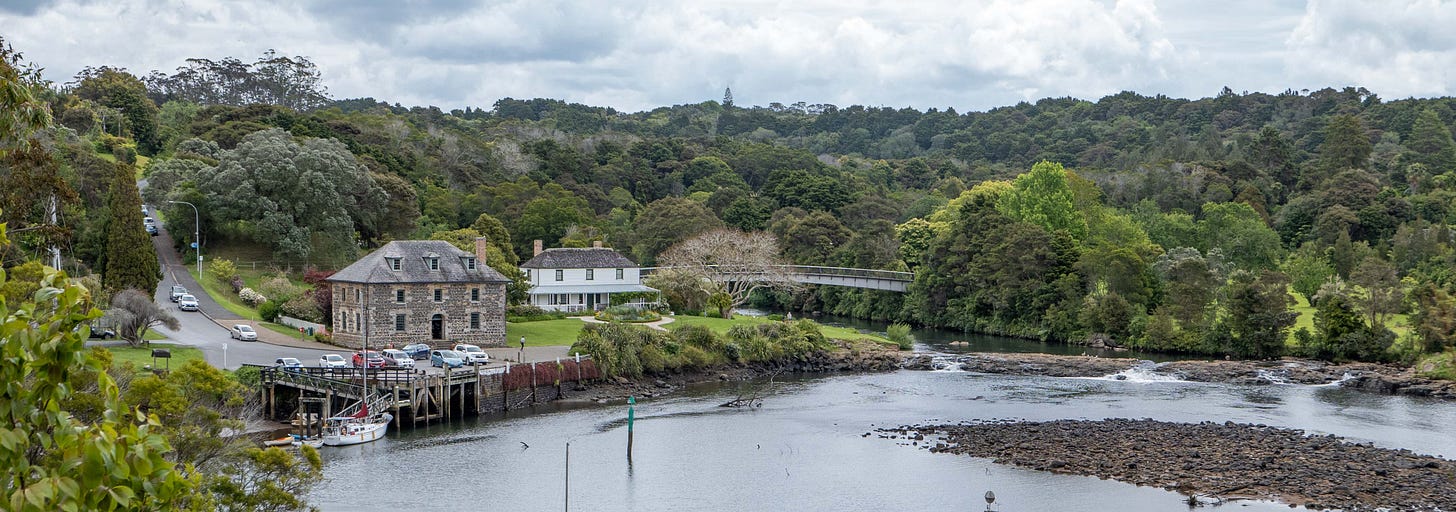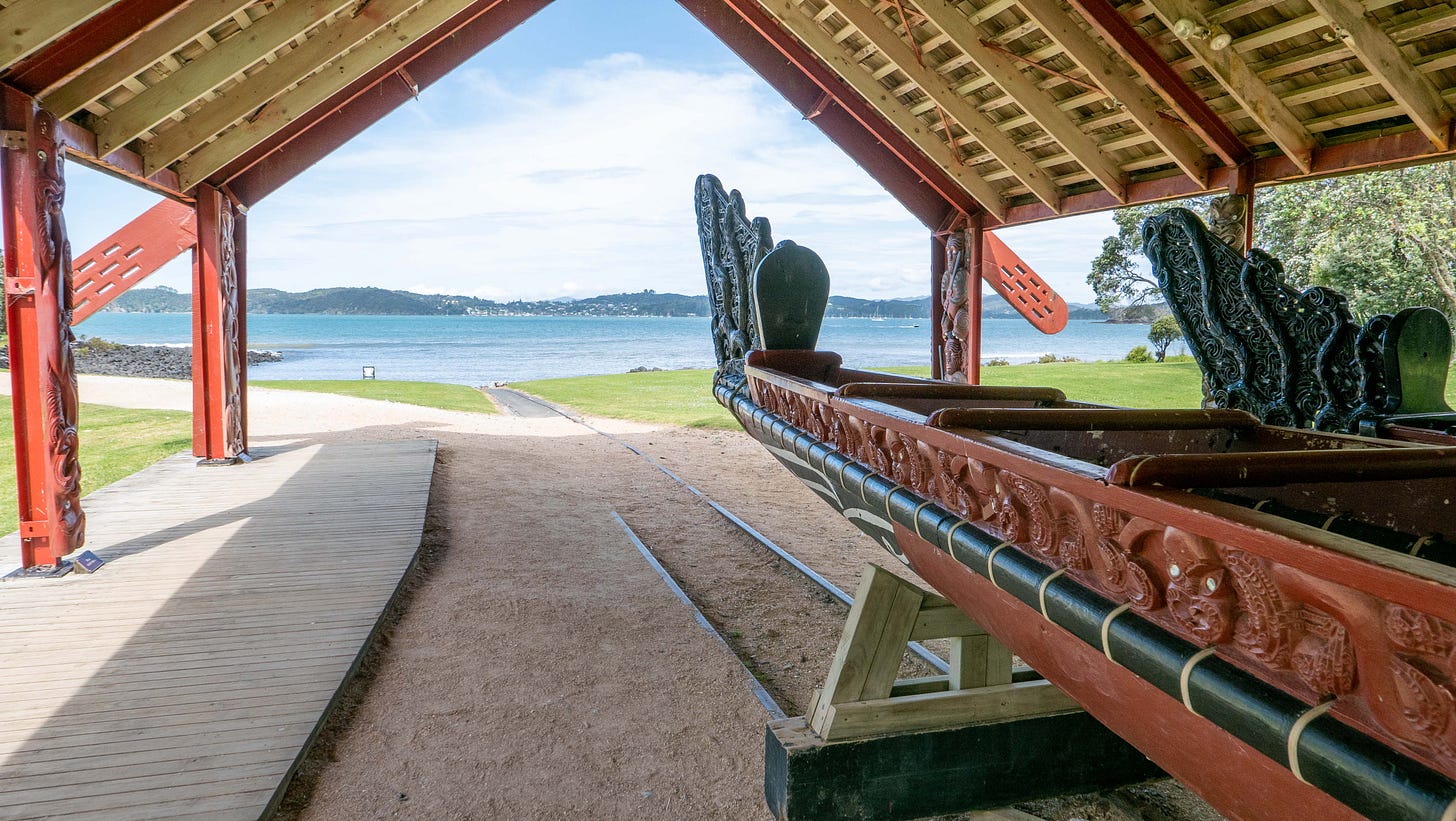Our Rotarian host was waiting for us at the bus stop. She took us straight to Kerikeri Rotary Club’s meeting, where I was giving a talk about walking the Camino. The evening was a whirlwind of introductions and discussions about a mixture of the Camino and our trip to New Zealand.
The Kerikeri area is the birthplace of colonial New Zealand – the perfect place to learn about the country’s history.
The Marsden Cross – where it all began
‘Watch out, Mike!’ On the far side of the single-lane bridge, with no warning, the tarmac ended and was replaced by stone chips. We were still on a public road a few miles from the car park. He slowed down just in time to protect the car’s paintwork and continued.
Eventually, we parked up and followed the signs to Marsden Cross. Through some trees, the view opened up over the bay. The ringworks of a small fort at Rangihoua were visible ahead. The hillsides were steep on either side and to the sea but more gentle inland. The fort would have looked formidable from a ship, while having enough land to grow crops on the rear slopes.
The path led us down to the bay, past a series of interpretation boards. Near the base of the fort, a stream and wetland provided water to the hundreds of Māori who lived there.
In the early 1800s, when whaling ships started to arrive in the bay, the local chief (Te Pahi) saw an opportunity to trade food, water and timber for goods the Europeans had that they didn’t, including tools for growing food and muskets that gave the tribe an advantage in battle.
Te Pahi and the Governor of New South Wales saw the benefit of a more formal alliance, and Te Pahi visited Sydney as the governor’s guest. This is where he met the Reverend Samuel Marsden. Marsden saw an opportunity to convert hundreds of people to Christianity, and Te Pahi realised that allowing missionaries to live with his people would ease trade relationships.
On Christmas Day in 1814, Samuel Marsden held the first Christian mass on New Zealand soil, and the first mission was soon built on the land behind the beach. By 1832, with other missions established in the area and the population and importance of Rangihoua declining, the mission closed.
A cross now marks the birthplace of Christianity in New Zealand – and the place where Europeans and Māori first chose to co-exist.
After immersing ourselves in the area’s history, we decided to immerse ourselves in the waters of the bay. As I stepped into the sea, I gasped – it felt like stepping into the frigid waters of the North Sea. I inched forward and deeper, until it was deep enough (and I was brave enough) to swim. After a few minutes, I stood up, covered in goosebumps, and smiled – it was a hot day, and I would soon recover. I dropped back into the water and swam for a few more minutes before warming up on the beach.
Kerikeri Mission House and the Stone Store
We followed the trail down the Kerikeri River from our host’s house. After a short distance, the rush of water was disturbed as it dropped down the face of Rainbow Falls. Our guidebook says that rainbows can always be seen here, whatever the weather. I spent a while searching for one, only to discover what I already knew from the laws of physics – that that suggestion is nothing more than wishful thinking.
We passed through a disinfection barrier with brushes and sprays for walkers’ footwear. Keeping our eyes peeled for kiwis, we walked through native woodland full of unfamiliar trees, yet surrounded by what were now familiar bird calls. Black-stemmed tree ferns added a prehistoric touch, their fronds waving in the breeze as though they had stood here for millennia. We turned over every leaf we could reach, looking for a silver fern, and eventually, there it was. It’s as much a symbol of national identity in New Zealand as the dragon is in Wales, so we were pleased to find one. Maybe we’ll find a dragon when we get home, too!
After a few miles, we reached the site of the second-oldest mission station in New Zealand at the Kerikeri basin, next to the Māori fort known as Kororipo Pā. The region’s chief, Hongi Hika, was keen to have the missionaries there and offered them his protection. A church was built in 1824, although the current wooden church is fifty years younger. It is dedicated to St James, and the symbol of the scallop shell can be seen in two of the stained-glass windows. Whenever I see a scallop shell, it reminds me of my pilgrimages on the Camino de Santiago (Way of St James), where pilgrims wear them hanging from their packs.
Kororipo Pā’s earthworks remain, and you can see why this was a tremendous defensive spot. It rises steeply above the confluence of two meandering rivers, with a narrow neck joining it to the neighbouring land. A little upstream, the Mission House is a white, wood-clad, two-storey building surrounded by a veranda. Māori did not build in stone; they stored kumara (sweet potatoes) to see them through the winter months in pits dug in the ground. The missionaries, however, brought wheat from home, from which they milled flour. Pits in the ground would not be a good storage option for flour, so they built a stone store next to the Mission House.
As the oldest stone building in New Zealand, it now houses a museum explaining this part of New Zealand’s history, which seems to have been pretty amicable.
However, things did not always continue this well.
Waitangi Treaty Grounds
The relationship between the missionaries and local Māori ultimately led to the signing of a treaty between around 500 Māori chiefs and the British Government (on behalf of the Crown) in 1840. The first signatures were made at what is now known as Waitangi Treaty Grounds, before a series of copies travelled around the country for approval from other chiefs.
We booked places on the first guided tour of the day. The sun was shining as we assembled and set up our earpieces. And then, we were off! The guide walked backwards at speed through most of the tour and peppered us with facts so quickly that we struggled to keep up. We visited the boat shed with a war canoe carved from giant kauri trees.
The guide talked about guardians and ensuring the boat belongs to you before becoming its captain. Without pausing for breath, she started to tell us about the treaty and reversed up the hill to the flagpole.
We spent the rest of the day at the treaty grounds, trying to understand what had happened. The long and short of it is that the treaty (prepared in both languages) was signed by a significant proportion of Māori chiefs, but their understanding of it differed from the Europeans’. It seems this was partly because of the translation and partly because the different parties had contradictory ideas of land ownership. This led to the New Zealand Wars a few years later and much strife since. The New Zealand government is now settling breaches of the treaty, which is proving to be a long and drawn-out process and causing further tension.
A hundred years after the treaty was signed, a Māori meeting house was constructed to join the colonial house on the site, so that all parties to the agreement are represented.
We assembled with a group of others outside this building, some distance from the entrance. A man wearing a corporate hoodie and carrying a white staff caught my attention. His hair was pulled back into a ponytail and decorated with a piece of bone. He was putting on a show, strutting around as though he was superior to everyone else.
After a while, a guide stood in front of the crowd and explained how we were to show our peaceful intentions before entering. The guide asked for a male volunteer to act as our chief. I tried not to bridle. Why can’t a woman take the role? And then, guess who stood forward? Mr Superior.
He greeted the guide the Māori way by touching noses and foreheads and breathing in. At that point, the door to the hall opened, and four traditionally dressed Māori stepped onto the veranda. They vibrated their hands (symbolising energy) and made big eyes and tongues at the crowd (to look fearsome). My spine tingled at the sound of a conch shell horn, as though it had awakened an ancient call to arms. One of the men stepped off the stoop and elaborately walked forward, brandishing his spear. Halfway to us, he dropped a leafy twig on the ground and retreated. I guess this is the equivalent of offering an olive branch in peace. It was our chief’s job now to step forward and accept it. He swung his staff and mimicked the steps of the other chief before retreating to the crowd.
On our behalf, he had accepted the peace offering, and we were allowed to proceed into the building. The cultural show that followed was clearly for tourists, and I hope we’ll experience the real deal later in the trip. However, it was still an impressive demonstration of the use of spears (to practice killing moves), long sticks (to improve and maintain flexibility) and short sticks (to exercise the left and right halves of the brain). Only the men demonstrated the use of spears, and only the women demonstrated the banging together of balls (poi). Balls attached to a rope are knocked together and against the body to create different sounds. I have no idea how they didn’t get horribly tangled, particularly with the longer ropes and when multiple balls were used.
After the show, we had a chance to walk around the hall, admiring the carvings that represent many of the different tribes that were signatories to the treaty. Around the entrance are carvings of the ancestors. Most are of stylised men, with one exception. Above the door is a woman with her legs spread wide. In Māori culture, warriors returning home crawled between the legs of a post-menopausal woman to rid themselves of the effects of killing. It seems that this can be done symbolically by placing a carving of a woman above the door.
Only as the site was about to close did we find out about the penguins that nest there. Unfortunately, there was no time to see them – we’ll have to look for them another day.
If you have enjoyed reading this newsletter, please like, comment - and subscribe to be sure you don’t miss out on future issues.
Do you know anyone else who would enjoy reading this? If so, please share!





